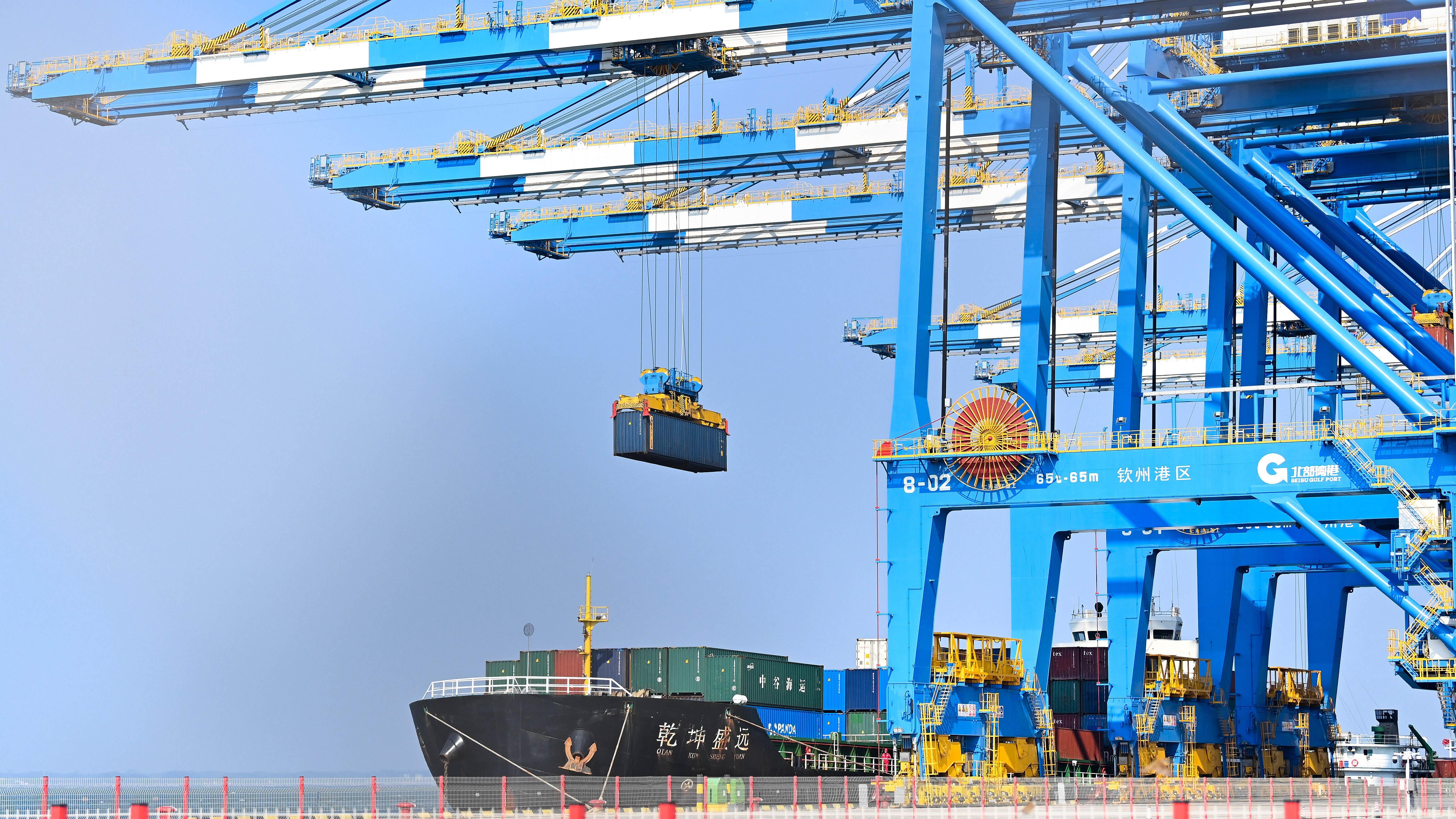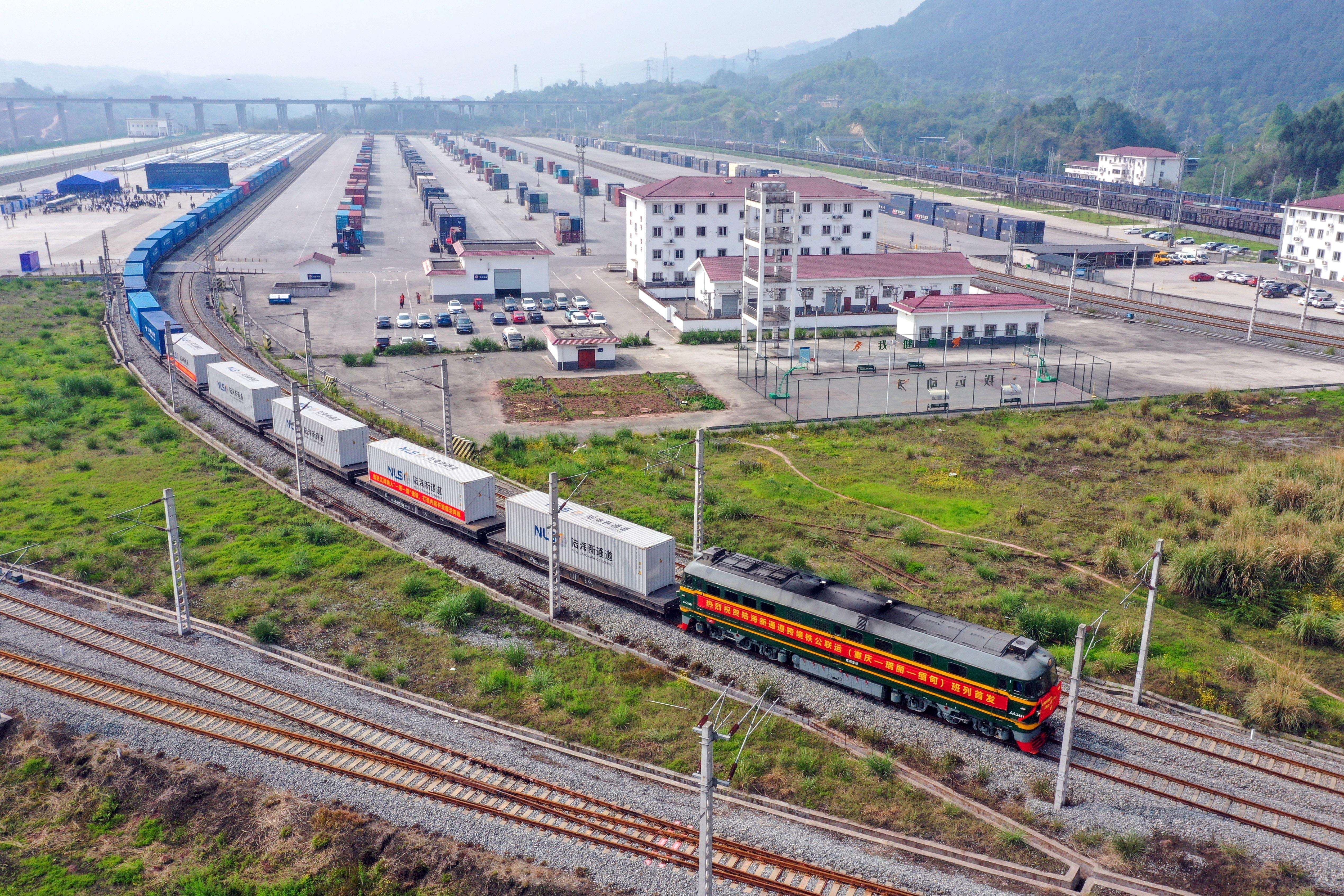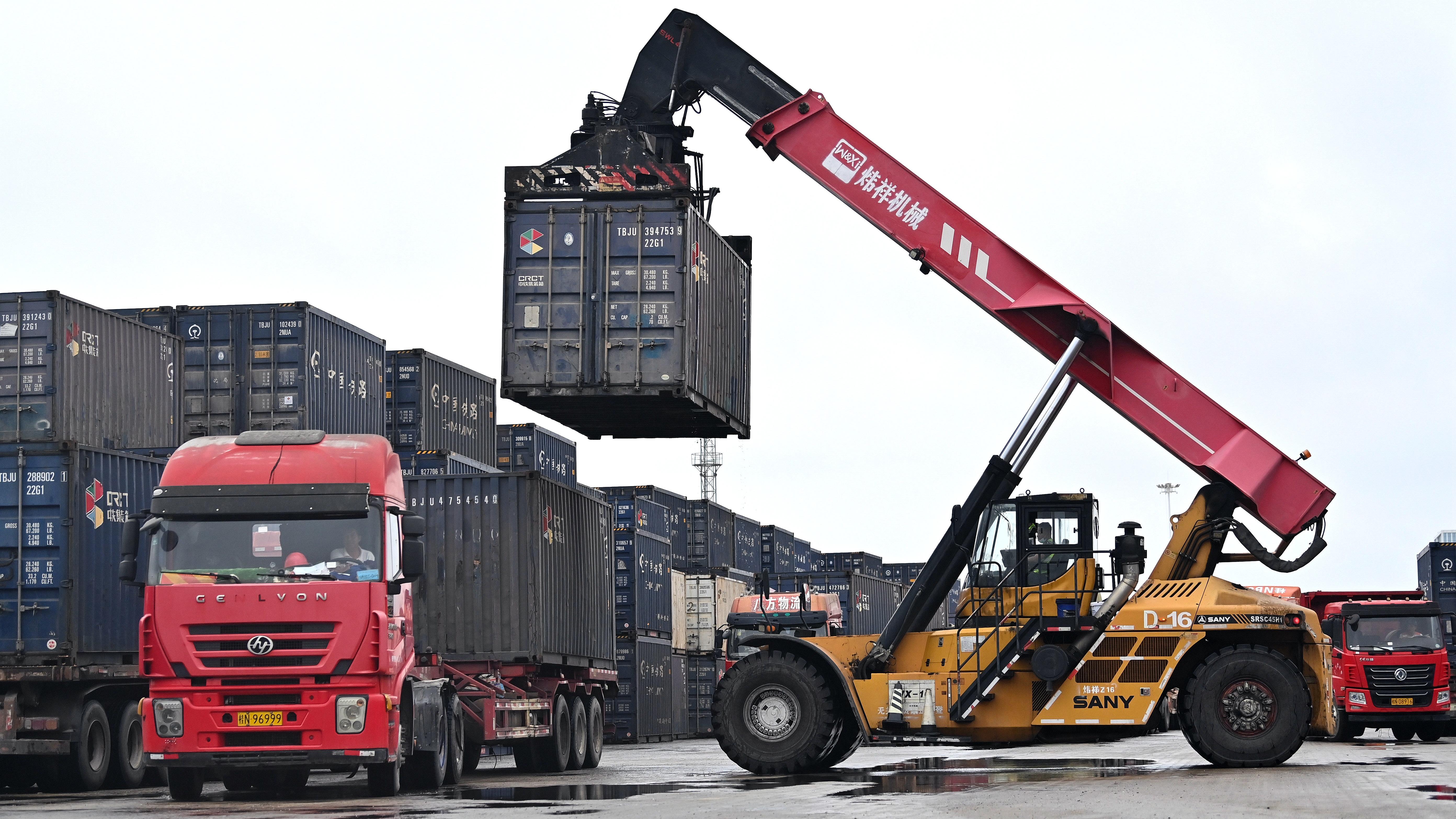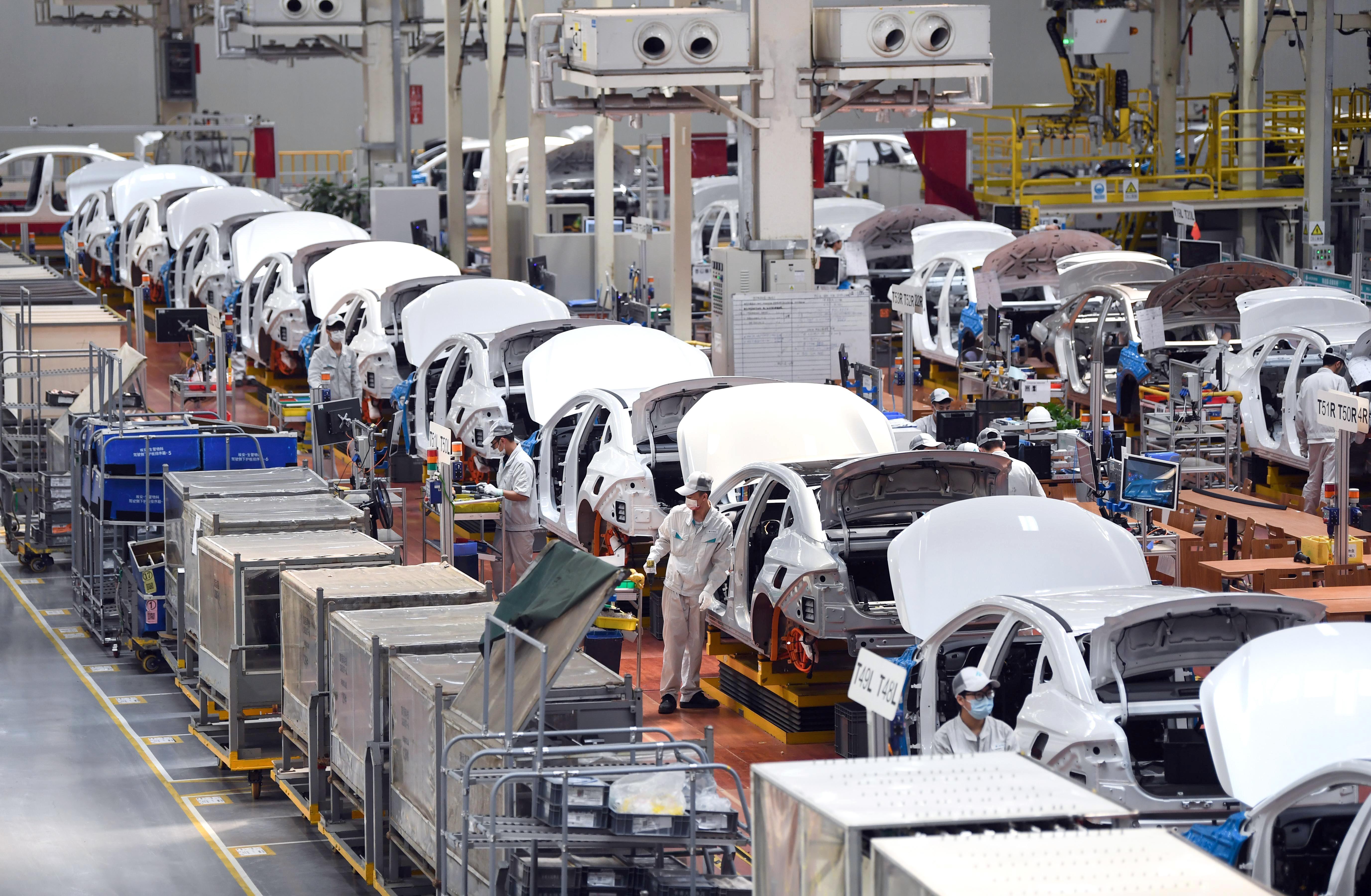Eco-friendly products such as NEVs, solar cells help China’s exports sector transition to new phase
 Containers are loaded onto a cargo vessel in Qinzhou Port, Guangxi Zhuang autonomous region, a transit point on the New International Land-Sea Trade Corridor. (PHOTO / XINHUA)
Containers are loaded onto a cargo vessel in Qinzhou Port, Guangxi Zhuang autonomous region, a transit point on the New International Land-Sea Trade Corridor. (PHOTO / XINHUA)
Ateam of drivers is busy loading new energy vehicles, or NEVs, onto a 14-deck vessel at Nansha Port in Guangzhou, the capital of Guangdong province.
The ship boasts more than 7,500 parking places, with about 540 such spots on each deck.
These vehicles, produced by domestic automakers such as BYD, Guangzhou Automobile Group Co, and Xpeng, will be driven on the roads of Thailand, Israel, Germany, Australia, and Brazil, among other countries, later this year.
China’s foreign trade is undergoing a green transformation, with traditional export categories such as clothing, household appliances, and furniture giving way to a new wave of tech-intensive, environmentally friendly products as the nation transitions to a new era of green and innovation-led growth.
Exports of China’s “new three” products — NEVs, lithium batteries and solar cells — witnessed a combined 61.6 percent year-on-year growth in the first half of this year, far outpacing overall exports expansion, data from the General Administration of Customs, or GAC, show.
Highlighting a trajectory aimed at setting China firmly on the path to modernization, government officials and market observers said the Communist Party of China’s ongoing thematic education campaign will further strengthen the nation’s robust supply capacity and its well-established industrial chain.
Launched in April, the education campaign enables members to equip themselves with the Party’s new theories, helps the entire Party achieve unity in thought, will, and action, and ultimately ensures that it strengthens its solidarity and better lead the Chinese people in forging ahead on a new journey.
As part of the campaign, the Party launched a research and fact-finding drive, with the aim of solving new problems and serving scientific decision-making.
Zhang Ke, deputy head of the GAC’s Guangdong sub-administration, which is responsible for coordinating customs work with a total of 14 southern, central, and southwestern regions of the country, said that to implement the education campaign effectively, customs authorities in Guangdong are primarily aiming to help the people and businesses.
After conducting comprehensive research and making productive visits to key export-oriented companies, several business operational issues and suggestions raised by exporters were promptly resolved, Zhang said.
He added that by adopting a meticulous approach, tailored measures were drawn up, with the main aim of bolstering the expansion of exports of the “new three” products from Guangdong. These strategic measures have resulted in substantial improvements to the overall export situation.
For example, the GAC’s Guangdong sub-administration has coordinated with local customs branches to implement several practical assistance measures for exporters. It has guided companies in standardizing their customs declarations and appointed specialized auditing personnel to significantly reduce the time cargo spends in transit at ports in Guangdong.
 A train leaves Chongqing to follow the trade corridor toward Yunnan province. (PHOTO / XINHUA)
A train leaves Chongqing to follow the trade corridor toward Yunnan province. (PHOTO / XINHUA)
The sub-administration has also used the advantages of China-Europe freight train services to lower customs clearance costs and provide optimal clearance for NEV exports, Zhang said.
For example, Xinsha Customs, a branch of Huangpu Customs, has implemented a 365-day, around-the-clock appointment-based clearance model for roll-on, roll-off vessels carrying vehicles, reducing the average quarantine and inspection time to within one hour. This has greatly enhanced turnover efficiency at terminals and reduced operational costs for shipping companies.
Earlier this year, the GAC launched a project to use opportunities arising from the thematic education campaign to address unnecessary inland river freight charges levied on imported goods. This issue was raised by domestic companies.
Relevant policies were drawn up based on comprehensive research, analysis, and assessment. These policies specify that when companies are unable to provide documentation after transporting their goods from coastal ports to destinations on inland rivers, data that meets specific criteria can serve as the basis for deduction claims.
Wang Yinghui, a division head at the GAC’s duty collection department, said this policy has been implemented effectively at ports in the Yangtze River Economic Belt.
“The policy of deducting inland river freight charges will be extended to the entire inland river basin in China, including the Pearl River and Minjiang River, benefiting more than 1,000 import companies. It is projected to save importers more than 67 million yuan ($9.3 million) on an annual basis,” she said.
Despite facing challenges posed by a complex global environment, China’s foreign trade reached 20.1 trillion yuan in the first half of this year, a 2.1 percent year-on-year rise. It was the first time the nation’s foreign trade value had exceeded 20 trillion yuan during a half-year period, GAC data showed.
In early August, the GAC unveiled 15 policy measures to support the growth of the New International Land-Sea Trade Corridor in an attempt to boost China’s trade with fellow signatories of the Regional Comprehensive Economic Partnership, or RCEP, agreement and expand interaction with trading partners worldwide.
 Cargo arriving at Qinzhou Port, Guangxi, is loaded onto trucks before being transported nationwide. (PHOTO / XINHUA)
Cargo arriving at Qinzhou Port, Guangxi, is loaded onto trucks before being transported nationwide. (PHOTO / XINHUA)
Wu Haiping, director-general of the GAC’s general operations department, said the new measures include linking the land-sea trade corridor better with booming China-Europe freight train services and the Yangtze River Economic Belt. They also help domestic companies to benefit fully from the RCEP agreement by further fostering smoother and more efficient trade routes connecting western China with key seaports and rail hubs in the Asia-Pacific region and Europe.
Launched in 2017, the land-sea corridor is a trade and logistics passage jointly established by provincial-level regions in western China and member economies of the Association of Southeast Asian Nations. It is also one of the key projects of the Belt and Road Initiative, or BRI.
Li Dongyu, deputy head of the GAC’s ideological and political affairs office, said a leadership group with six sub-working groups has been established to urge all Party members to comprehensively study and promote high-quality development and advance Chinese modernization through the thematic education campaign. The subgroups include those covering documentation, publicity, rectification, and improvement.
The leadership group had held several high-level meetings and conducted numerous field research trips and study activities nationwide by the end of July, to improve the GAC’s governance capacity in advancing toward the goal of national rejuvenation through the Chinese path toward modernization.
Chen Jianqi, a professor at the Party School of the Central Committee of the Communist Party of China (National Academy of Governance), said the Party’s 20th National Congress in October drew up a blueprint for comprehensively building a modern socialist country. However, achieving this objective remains a challenging task for the Party and the nation.
As a result, it is vital for CPC officials to adeptly comprehend the principles of the Party’s novel theories, Chen said, adding that such comprehension is essential to strengthen officials’ ability to effectively respond to the population’s pressing needs and overcome complex challenges that need resolving.
Extensive fact-finding activities are a key part of the thematic education campaign. Officials from the Ministry of Commerce have held roundtable meetings with foreign companies, set up task forces for key foreign-invested projects, and introduced new policy measures to shore up economic growth and push for continuous progress in deepening reforms and expanding opening-up.
In July, the ministry said the government would revise administrative measures for strategic foreign investment in listed companies. The move is aimed at encouraging overseas companies to invest in the Chinese stock market.
 New energy vehicles are produced at the Guangzhou Automobile Group Co factory in Guangzhou, Guangdong province. (PHOTO / XINHUA)
New energy vehicles are produced at the Guangzhou Automobile Group Co factory in Guangzhou, Guangdong province. (PHOTO / XINHUA)
Guo Tingting, vice-minister of commerce, said that given the slowdown in global economic recovery and decline in cross-border investment, China will continue to shorten the negative list for foreign investment and offer overseas companies prompt assistance in solving their problems.
To encourage foreign companies to play a bigger role in the Chinese market, senior officials from the Ministry of Commerce have held several roundtable conferences and meetings this year with top corporate executives and heads of foreign business associations from Japan, Germany, the Netherlands, Singapore, and the United States.
The officials said overseas companies could expect more growth opportunities, as China is progressing with domestic modernization in an all-round manner and unswervingly advancing high-standard opening-up.
Zhu Bing, director-general of the ministry’s foreign investment administration department, said the arrangements for roundtable and regular meetings will further expand channels for gathering feedback on foreign companies’ operational difficulties. This will help address their concerns promptly, in addition to assisting their stable development in China.
“Apart from effectively implementing existing policies, the government will give priority to addressing common concerns raised by foreign companies, including fair competition and investment facilitation,” he said, adding that new measures will be introduced later this year to boost foreign investors’ confidence in China.
The nation’s massive market, well-developed industrial system, and strong supply chain competitiveness were highlighted by Francis Liekens, vice-president for China at Atlas Copco Group, the Swedish industrial equipment manufacturer.
He said China remains one of the world’s most dynamic markets. The country has witnessed persistent growth despite geopolitical changes and challenges posed by the COVID-19 pandemic, Liekens noted, adding that the trend will continue in coming years.
China is transitioning from being the “world’s factory” to a high-end manufacturer as domestic consumption grows, Liekens said. The trend toward localization has fueled growth in many sectors over the past seven years, including electronics, semiconductors, automotive, petrochemicals, transportation, aerospace, and green energy. Atlas Copco will work with all industries in the country, but particularly with these sectors, Liekens said.
“We are benefiting from this favorable climate because we have invested a lot in innovation to develop and extend our local products and solutions,” he said. “You have to develop, transform and be innovative to stay relevant in China, where competition is getting stronger and market needs change at the speed of light.”
Similar action has been taken by Thyssenkrupp, a German industrial engineering conglomerate. In July, the company announced that one of its subsidiaries from the high-end manufacturing sector had launched a new production line with an investment of 500 million yuan, to produce seamless rolled rings for large megawatt wind turbines, at its plant in Xuzhou, Jiangsu province.
It is the fourth time the company has invested in the factory since the plant was established in 2005. The new investment will boost the factory’s production capacity by 150,000 metric tons.
Winfried Schulte, CEO of Thyssenkrupp Rothe Erde, a Thyssenkrupp subsidiary that supplies bearings and seamless rolled rings for various industrial applications, said: “China is one of the most important markets for our business. Wind turbines are designed gradually with a larger size and more megawatts. Seamless rolled rings of high quality are one of the key factors for safe operation.”
In Beijing, Zhao Ping, vice-dean of the academy at the China Council for the Promotion of International Trade, said that as well as benefiting from the nation’s technological advances, many foreign companies see China as a gateway to the broader Asia-Pacific region. They also view investing in China as a means of gaining access to the country’s vast network of supply chains and distribution channels.
This view is supported by the latest data from the Ministry of Commerce, which show that in the first half of this year, the number of newly established foreign-invested enterprises in China reached 24,000, a year-on-year rise of 35.7 percent.


